
Ewenny Priory, in Ewenny in the Vale of Glamorgan, Wales, was a monastery of the Benedictine order, founded in the 12th century. The priory was unusual in having extensive military-style defences and in its state of preservation; the architectural historian John Newman described it as “the most complete and impressive Norman ecclesiastical building in Glamorgan”. Following the Dissolution of the Monasteries, parts of the priory were converted into a private house by Sir Edward Carne, a lawyer and diplomat. This Elizabethan house was demolished between 1803-1805 and replaced by a Georgian mansion, Ewenny Priory House. The house is still owned by the Turbervill family, descendants of Sir Edward. The priory is not open to the public apart from the Church of St Michael, the western part of the priory building, which continues to serve as the parish church for the village. The priory is in the care of Cadw and is a Grade I listed building.

Powis Castle is a medieval castle, fortress and grand country house near Welshpool, in Powys, Wales. The seat of the Herbert family, earls of Powis, the castle is known for its formal gardens and for its interiors, the former having been described as "the most important", and the latter "the most magnificent", in the country. The castle and gardens are under the care of the National Trust. Powis Castle is a Grade I listed building, while its gardens have their own Grade I listing on the Cadw/ICOMOS Register of Parks and Gardens of Special Historic Interest in Wales.

LlanvihangelCourt, Llanvihangel Crucorney, is a Tudor country house in Monmouthshire, Wales. The architectural historian John Newman, in his Gwent/Monmouthshire volume of The Buildings of Wales series described the court as "the most impressive and richly decorated house of around 1600 in Monmouthshire". The origins of the house are medieval, with a traditional date of construction of 1471. The building was given its present appearance by a substantial enlargement and re-casing of circa 1600 by Rhys Morgan, of the family of the original owners. In the very early 17th century it was owned briefly by Edward Somerset, 4th Earl of Worcester.
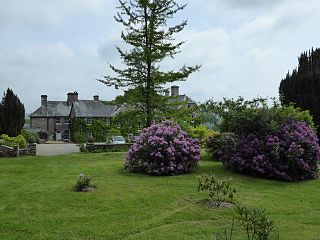
The Argoed, Penallt, Monmouthshire, Wales, is a Victorian country house dating from the 1860s, with earlier origins from the late 16th and early 17th centuries. It is a Grade II* listed building and the garden is listed on the Cadw/ICOMOS Register of Parks and Gardens of Special Historic Interest in Wales. The English meaning of the Welsh word argoed is 'by a wood'.
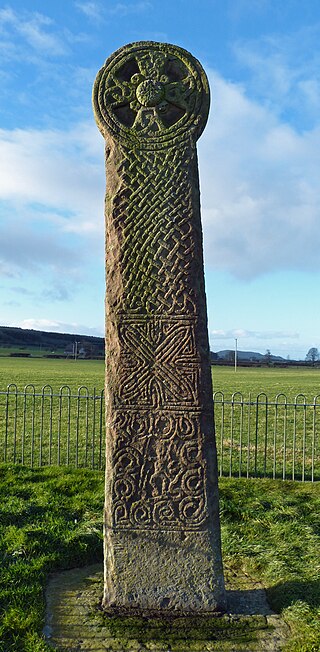
Maen Achwyfan Cross near the village of Whitford, Flintshire, Wales, is a high cross dating from the late 10th or early 11th century. Standing 3.4 metres (11 ft) high, it is the tallest wheel cross in Britain, and a Scheduled monument.
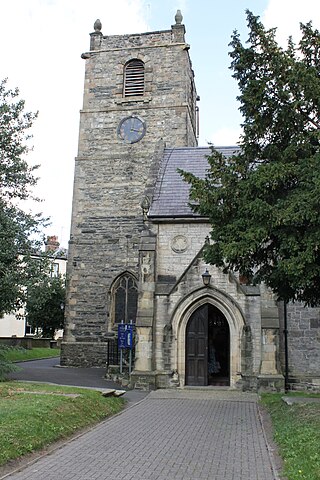
St Collen's Church is a parish church in the town of Llangollen, Denbighshire, Wales. The first church on the site was founded by Collen in the 6th century. Nothing of this building remains. A new church was built in the 13th century, in the Early English Gothic style. This was developed in the succeeding centuries, and then almost completely rebuilt in the 19th century. The architect of the Victorian reconstruction was Samuel Pountney Smith, who retained little of the earlier church, with the exception of the tower. The churchyard contains the grave of the Ladies of Llangollen, Eleanor Charlotte Butler and Sarah Ponsonby, and their servant Mary Carryl, who lived at the nearby Plas Newydd. In November 2021 the first blessing of a gay partnership in a Church in Wales church was held at St Collen's. The church is an active parish church in the Diocese of St Asaph. It is designated by Cadw as a Grade I listed building.

Newbridge Lodge is a gatehouse to the Wynnstay estate near Ruabon, in Wrexham County Borough, North Wales. Designed by Charles Robert Cockerell in 1827–1828 for Sir Watkin Williams-Wynn, 5th Baronet, it is a Grade I listed building. Its gates and railings have a separate Grade I listing.
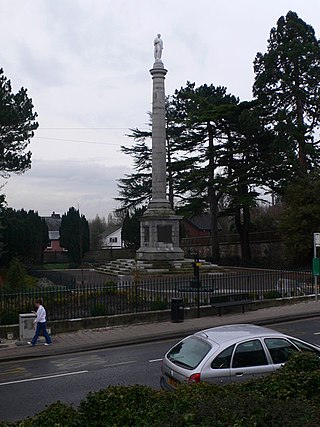
The Pierce Memorial Garden is an urban park in the town of Denbigh, in Denbighshire, Wales. It was constructed between 1874 and 1887 and commemorates Evan Pierce who donated the land. Pierce, a doctor, sat on Denbigh Town Council for 50 years and served five terms of office as mayor. The garden is registered Grade II on the Register of Parks and Gardens of Special Historic Interest in Wales. The statue depicting Pierce is listed at Grade II*. The park is managed by Denbighshire County Council.

Gwaenynog is a small estate about 1 km (0.62 mi) to the south-west of the town of Denbigh, Wales. Its origins are mediaeval when it was built as a house for the Myddelton family. The Myddeltons claimed descent from Rhirid Flaidd, of the House of Cunedda, hereditary Kings of Gwynedd. Anglicising themselves and their name after the conquest of Wales, they thrived as prominent local landowners and politicians. Basing themselves ultimately at Chirk Castle, they served as receivers of Denbigh, governors of its castle and as members of parliament for Denbighshire and Denbigh Boroughs.

Rhondda Cynon Taf is a county borough in South Wales. It is located to the north-west of Cardiff and covers an area of 424 km2 (164 sq mi). In 2021 the population was approximately 237,500.

Powys is a county and preserved county in Wales. It covers an area of 5,180 km2 (2,000 sq mi) and in 2021 the population was approximately 133,600.

Merthyr Tydfil County Borough is located in the historic county of Glamorgan in Wales and takes its name from its largest town. The county borough covers an area of 111 km2 (43 sq mi) and had a population of approximately 58,900 in 2021. There are three sites on the register of parks and gardens in Merthyr Tydfil County Borough. Two are listed at Grade II*, and one is Grade II.

Monmouthshire is a county and principal area of Wales. It borders Torfaen and Newport to the west; Herefordshire and Gloucestershire to the east; and Powys to the north. The largest town is Abergavenny, with other large settlements being Chepstow, Monmouth, and Usk. The present county was formed under the Local Government (Wales) Act 1994, and comprises some sixty percent of the historic county. Between 1974 and 1996, the county was known by the ancient title of Gwent, recalling the mediaeval Welsh kingdom. The county is 850 km2 in extent, with a population of 93,200 as of 2021.

Bridgend County Borough is a county borough in south-east Wales. It covers an area of 251 km2 (97 sq mi). In 2021 the population was approximately 145,800.

Caerphilly County Borough is a county borough in south-east Wales. It covers an area of 227 km2 (88 sq mi). In 2021 the population was approximately 176,000.

The Vale of Glamorgan is a county borough in south-east Wales. It covers an area of 331 km2 (128 sq mi) and in 2021 the population was approximately 132,500.

The City and County of Swansea is a principal area in south Wales. It covers an area of 380 km2 (150 sq mi) and in 2021 the population was approximately 237,800.

Pembrokeshire is a county in the south-west of Wales. It covers an area of 1,619 km2 (625 sq mi). In 2021 the population was approximately 123,700.
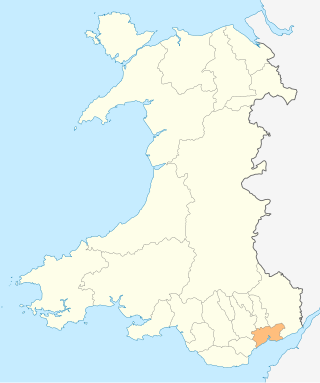
Newport is a city and county borough in the south of Wales. It covers an area of 190 km2 (73 sq mi) and in 2021 the population was approximately 159,700.

Conwy County Borough is a county borough in the north of Wales. It covers an area of 1,126 km2 (435 sq mi) and had a population of approximately 114,800 in 2021.





















